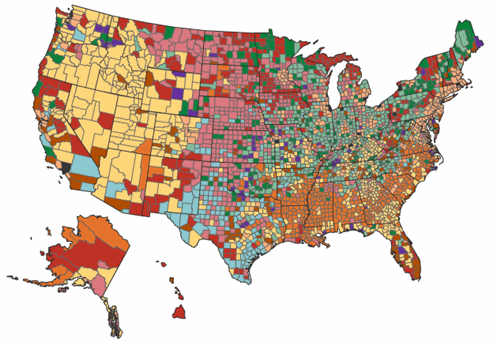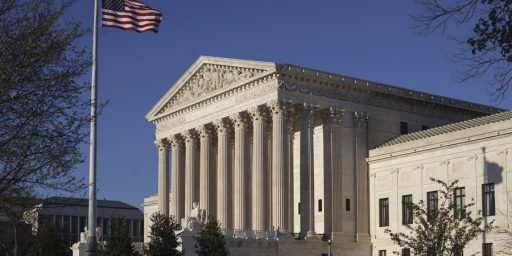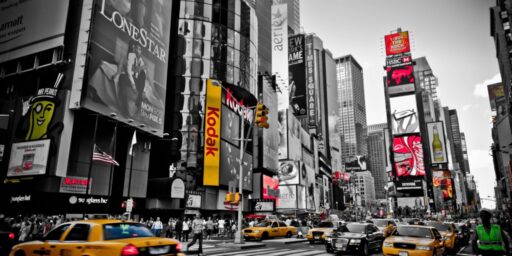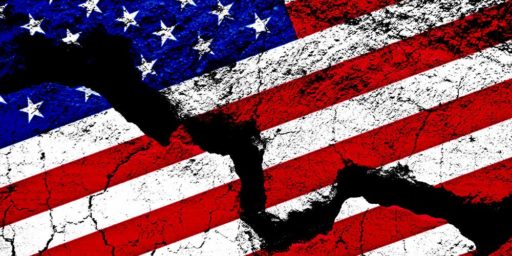Patchwork America
The folks at the Christian Science Monitor argue that the division of America into Red and Blue states based on aggregate voting behavior is flawed. They propose, instead, that we’re a “Patchwork Nation” comprised of at least eleven different voter communities.

Nearly 305 million people live in the United States, according to the US Census Bureau. Yet in recent elections it’s all been about fitting into two categories: red states that vote Republican and blue states that vote Democratic. But this red/blue breakdown of political opinion doesn’t explain what underpins the voters’ decisions.
That’s what this effort, funded by the Knight Foundation, a nonprofit philanthropic organization based in Miami, explores in real time during the 2008 presidential campaign.
We’ve identified 11 places across the US that represent distinct types of voter communities. They are Monied ‘Burbs, Minority Central, Evangelical Epicenters, Tractor Country, Campus and Careers, Immigration Nation, Industrial Metropolis, Boom Towns, Service Worker Centers, Emptying Nests, and Military Bastions. For example, Sioux Center, Iowa, typifies Tractor Country.
The basic premise here is reasonable enough. Brad DeLong and others have argued for years that painting America Red and Blue over-emphasized differences and that we’re really Purple. This project goes much further:
Boom Towns (Eagle, CO) Midsize cities and smaller towns with well-balanced economies of affluence, education, and professional employment; growing ethnic diversity, some retired elderly with high incomes.
Military Bastions (Hopkinsville, KY) High levels of employment in military or related government employment; often adjacent to major military installations, private military contractors, or have a history of military-dependent economies; middle income, transient, younger populations, with some trade and service workers in the local economy.
Campus and Careers (Ann Arbor, MI) High percentage of the population between 18-34, few retirees or elderly; includes university/college towns and locations with high employment in education and educational services; high levels of formal education; religious diversity, secularism.
Minority Central (Baton Rouge, LA) Lower-income counties with large proportions of African-Americans and native Americans on Indian reservations; low population growth or steady population losses, high unemployment and poverty; low-end housing stock; African-American locales are concentrated within the Deep South.
Emptying Nests (Clermont, FL) Middle-income, retirement age; and baby-boom populations; presence of evangelical and mainline Protestants, fewer Catholics, stable but not booming economies.
Monied ‘Burbs (Los Alamos, NM) High-income counties, with high professional employment and formal education; high expenditures by consumers on new vehicles, luxury goods, property taxes, and charitable giving; midsize in terms of population and population density, primarily within metro areas; family age populations, low density housing; predominantly white, but with some Asian-American presence.
Evangelical Epicenters (Nixa, MO) Briskly growing small and midsize towns with family age populations; middle income with some affluent and poor; low incidence of mainline Protestant and Catholic churchgoers, higher incidence of evangelical adherents, particularly in the South and border states; Mormons in the West; some minority presence, chiefly blacks (in the South) and Latinos (in the West).
Service Worker Centers (Lincoln City, OR) Midsize cities and smaller towns with very high percentages employed in trade and service businesses but not manufacturing or agriculture; many new residents, growing Latino populations; more Catholics and fewer Evangelicals or mainline Protestants.
Immigration Nation (El Mirage, AZ) High percentages of Latinos and Asians; immigrants living in midsize to larger cities; moderately high levels of unemployment; Roman Catholic with sprinkling of religious diversity; lower income with moderate to high percentage in poverty.
Tractor Country (Sioux Center, IA) Predominantly white, smaller towns and more remote counties outside of metropolitan areas; low level of manufacturing employment, high levels of self-employment, employment in agriculture, as well as small-town retail and wholesale trade; Lutheran, Reformed, and mainline Protestant adherents predominate in the upper Midwest.
Industrial Metropolis (Philadelphia, PA) Older Northeastern and Midwestern cities once dependent on manufacturing; diverse populations, including significant Jewish populations; some high-end residents in established historically wealthy neighborhoods, mixed with lower income populations.
Much, much more here, including blogs, interactive maps, a chance to fill out your own demographic profile, and more.
It’s an interesting project but there’s a certainly David Brooksian “Bobos in Paradise” feel to it. I live in the “Monied ‘Burbs” of Northern Virginia. Does my community really have all that much in common with Los Alamos, New Mexico? Color me skeptical.
Albert Einstein said that, “Everything should be made as simple as possible, but no simpler.” Red versus Blue is almost certainly too simple. The political cultures of Ohio, Alabama, and Idaho aren’t identical simply because they made the same aggregate choice between two parties. Eleven sub-groups, divided down to the county level, is much more helpful than that. But it takes away a lot of parsimony while giving too strong an impression of precision.






In Presidential politics, however, the Red/Blue distinction is all that matters.
This seems like a colossal waste of effort and indicative of nothing more than a desire to show off pretty maps.
Until we get rid of the electoral college, making a lot of fuss about sub-geographies is pretty pointless.
I think there’s something wrong with their classifications. For example, Boston, New York, Detroit, Chicago, and Los Angeles are all classified as “Industrial Metropolises”. There are several problems with this. First is metropolis, yes, industrial may not so much. Is Los Angeles an industrial metropolis? As best as I can tell these cities have different economies, are in different stages, and have different problems. What they have in common is that they vote Democratic reliably.
But everything isn’t about winning and losing elections. CSM isn’t quite committing political science here but it’s at least amateur sociology.
Or even about winning and losing Presidential elections. This data may be much more relevant to down-ticket races where such a breakout does indeed matter.
It actually looks to give a pretty good regional breakout though:
New England
South
Center-East
Center-West
West
and Texas.
They got me as and living in the Monied Burbs, I’m just a poor white boy and still am from a neighborhood that was more like and still is like the outskirts of an inner city, but it’s still kinda neat, except I don’t think they went micro enough.
In looking at the internal fights with both parties, this cycle, that statement would seem to contain an extra word…”Almost”.
… and….
Obviously incorrect, it DOES in fact matter, at the presidential levels, and not just downticket, if we are to take the number of Clinton supporters that won’t vote for Obama and versa-Visa as any indication… as well as the number of Republicans saying they won’t vote for McCain.
What is striking to me is how so much of this comes down to subcultures, to the point of giving much credibility to the conept of the infleunce of the stereotypical regional subcultures…(Incorporating both the good and bad) being relfected in the politics of the area.
I wonder about how this speaks to the issues of multiculturalism as it has been embraced by northeastern liberals, particualrly?
Of course these things are easy to pick apart, but special mention seems to be warranted for their aggregation of “Minority Central,” which covers most of the Deep South, but also includes Navajo Nation, northern Alaska, Indianapolis and East St. Louis. If they are saying these areas are similar, I call do over.
I do think there is something to the monied burbs contention. Northern Virginia, Silicon Valley, the North Carolina Triangle, and the burbs of places like Denver, Boston, Chicago, LA, Phoenix, do have a lot of similarities, regardless of the red/blue of their state. They tend to like the economic policies of the GOP and the social policies of the Democrats. But the authors got carried away lumping some of the smaller places that are more culturally conservative. Los Alamos, sure, lots of Ivy League and so forth there. But Aiken, SC? And Wichita, KS and Jackson, MS may be a step closer but they still don’t fit.
Hello all.
As the person behind Patchwork Nation let me say that I enjoy reading all your comments — and agree with a great many of them.
Some may feel 11 groups are too few, some too many. Honestly, in a place as big and diverse as the United States you could have 100. We needed a number that we thought sufficiently accounted for differences but didn’t overwhelm and aimed for somewhere between 10 and 15. Using that as a target with the data we had, we wound up with 11.
Are they perfect? No. But overall, I think you’ll find the communities we’ve grouped really do share a lot of commonalities.
And don’t let that map on the front page fool you. Those are the BEST matches for those counties with our groups not the ONLY ones. Look at the inside pages of the site like this one and you see more nuanced maps that take differences into account.
The “county” problem is harder to get around. Counties are better units than states or even congressional districts as a measure. There are more of them, which allows for more “granularity.” But they can still be fairly large and diverse — especially out West.
Regardless, thanks to you all for coming by the site. Please check back. We’re going to be doing some interesting stuff with economic and donation data in the coming weeks and months